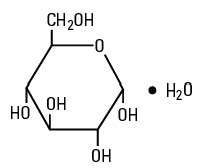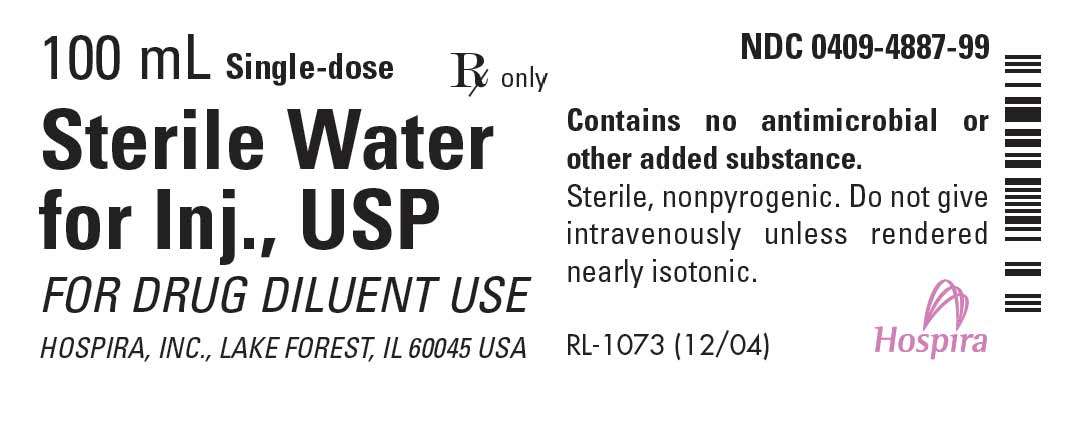Sterile Water
Parenteral Diluents or Solvents for Drugs
FULL PRESCRIBING INFORMATION: CONTENTS*
- STERILE WATER DESCRIPTION
- CLINICAL PHARMACOLOGY
- STERILE WATER INDICATIONS AND USAGE
- STERILE WATER CONTRAINDICATIONS
- WARNINGS
- PRECAUTIONS
- STERILE WATER ADVERSE REACTIONS
- OVERDOSAGE
- STERILE WATER DOSAGE AND ADMINISTRATION
- HOW SUPPLIED
- RL-1073
FULL PRESCRIBING INFORMATION
Rx only
STERILE WATER DESCRIPTION
The following preparations are designed solely for parenteral use only after addition of drugs that require dilution or must be dissolved in an aqueous vehicle prior to injection:
10% Dextrose Injection, USP is a sterile, nonpyrogenic solution of dextrose in water for injection. Each mL contains dextrose, hydrous 50 or 100 mg. 10% Dextrose Injection, USP is hypertonic. They contain no bacteriostat or antimicrobial agent or added buffer and are supplied only in single-dose containers to dilute or dissolve drugs for injection. See Table for other characteristics.
Although Dextrose Injection, USP is classified only as a fluid and nutrient replenisher, the small volumes supplied for diluting or dissolving other drugs are used only as pharmaceutic aids for parenteral injection of other drugs. 10% Dextrose Injection, USP may also be used to increase the specific gravity of an anesthetic solution utilized in hyperbaric spinal anesthetic techniques. When used for this purpose, the volume used should be governed by the manufacturer’s recommendation for the drug to be administered.
Dextrose, USP is chemically designated C6H12O6 • H2O (D-glucose monohydrate), a hexose sugar freely soluble in water. Dextrose, hydrous has the following structural formula:

0.9% Sodium Chloride Injection, USP is a sterile, nonpyrogenic, isotonic solution of sodium chloride and water for injection. Each mL contains sodium chloride 9 mg. It contains no bacteriostat or antimicrobial agent or added buffer and is supplied only in single-dose containers to dilute or dissolve drugs for injection. The solution may contain hydrochloric acid or sodium hydroxide for pH adjustment.
Sodium Chloride, USP is chemically designated NaCl, a white crystalline compound freely soluble in water.
Sterile Water for Injection, USP is a sterile, nonpyrogenic preparation of water for injection, which contains no bacteriostat, antimicrobial agent or added buffer and is supplied only in single-dose containers to dilute or dissolve drugs for injection. For I.V. injection, add sufficient solute to make an approximately isotonic solution.
Water for Injection, USP is chemically designated H2O.
CLINICAL PHARMACOLOGY
When used as a pharmaceutic aid, 10% Dextrose Injection, USP serves as an appropriate diluent or solvent for parenteral administration of certain other drugs and usually involves volumes too small to affect carbohydrate or water balance except possibly in newborn or very small infants. Dextrose injected parenterally undergoes eventual absorption and oxidation to carbon dioxide and water.
Sodium chloride in water dissociates to provide sodium (Na+) and chloride (Cl–) ions. These ions are normal constituents of the body fluids (principally extracellular) and are essential for maintaining electrolyte balance.
The distribution and excretion of sodium (Na+) and chloride (Cl–) are largely under the control of the kidney which maintains a balance between intake and output.
The small volume of fluid and amount of sodium chloride provided by 0.9% Sodium Chloride Injection, when used only as an isotonic vehicle for parenteral injection of drugs, is unlikely to exert a significant effect on fluid and electrolyte balance except possibly in newborn and very small infants.
Water is an essential constituent of all body tissues and accounts for approximately 70% of total body weight. Average normal adult daily requirement ranges from two to three liters (1.0 to 1.5 liters each for insensible water loss by perspiration and urine production).
Water balance is maintained by various regulatory mechanisms. Water distribution depends primarily on the concentration of electrolytes in the body compartments and sodium (Na+) plays a major role in maintaining physiologic equilibrium.
The small volume of fluid provided by Sterile Water for Injection, USP when used only as a pharmaceutic aid for diluting or dissolving drugs for parenteral injection, is unlikely to exert a significant effect on fluid balance except possibly in newborns or very small infants.
STERILE WATER INDICATIONS AND USAGE
These preparations are indicated only for diluting or dissolving drugs intended for parenteral injection, according to instructions of the manufacturer of the drug to be administered.
STERILE WATER CONTRAINDICATIONS
Sterile Water for Injection, USP must be made approximately isotonic prior to use.
WARNINGS
Intravenous administration of Sterile Water for Injection without a solute may result in hemolysis.
Some drugs for injection may be incompatible in a given vehicle, or when combined in the same vehicle. Consult with pharmacist, if available.
When diluting or dissolving drugs, mix thoroughly and use promptly.
Do not store reconstituted solutions of drugs for injection unless otherwise directed by the manufacturer of the solute.
PRECAUTIONS
Do not use unless the solution is clear and seal intact. Do not reuse single-dose containers, discard unused portion.
Consult the manufacturer’s instructions for choice of vehicle, appropriate dilution or volume for dissolving the drugs to be injected, including the route and rate of injection.
Inspect reconstituted (diluted or dissolved) drugs for clarity (if soluble) and freedom from unexpected precipitation or discoloration prior to administration.
Pregnancy Category C . Animal reproduction studies have not been conducted with dextrose or sodium chloride. It is also not known whether dextrose or sodium chloride can cause fetal harm when administered to a pregnant woman or can affect reproduction capacity. Dextrose or sodium chloride should be given to a pregnant woman only if clearly needed.
Carcinogenesis, Mutagenesis, Impairment of Fertility
Studies with solutions in polypropylene syringes have not been performed to evaluate carcinogenic potential, mutagenic potential or effects on fertility.
Drug Interactions
Some drugs for injection may be incompatible in a given vehicle, or when combined in the same vehicle. Consult with pharmacist, if available.
When diluting or dissolving drugs, mix thoroughly and use promptly.
Do not store reconstituted solutions of drugs for injection unless otherwise directed by the manufacturer of the solute.
Do not use unless the solution is clear and seal intact.
STERILE WATER ADVERSE REACTIONS
Reactions which may occur because of these solutions, added drugs or the technique of reconstitution or administration include febrile response, local tenderness, abscess, tissue necrosis or infection at the site of injection, venous thrombosis or phlebitis extending from the site of injection and extravasation.
If an adverse reaction does occur, evaluate the patient, institute appropriate countermeasures, and if possible, retrieve and save the remainder of the unused vehicle for examination.
OVERDOSAGE
Use only as diluents or solvents. These parenteral preparations are unlikely to pose a threat of carbohydrate, sodium chloride or fluid overload except possibly in newborn or very small infants.
STERILE WATER DOSAGE AND ADMINISTRATION
The volume of the preparation to be used for diluting or dissolving any drug for injection is dependent on the vehicle concentration, dose and route of administration as recommended by the manufacturer of the drug to be administered.
These parenterals should be inspected visually for particulate matter and discoloration prior to administration, whenever solution and container permit. See PRECAUTIONS .
HOW SUPPLIED
Small volume parenteral preparations are supplied in various sizes of glass or plastic containers as shown in the Table.
|
NDC Number |
Product |
Container |
Volume (sizes) |
mOsmol (calc) |
pH |
|
0409-1954-01 |
0.9% Sodium Chloride Inj. |
Ampul |
5 mL |
0.308/mL |
5.0 (4.5 to 7.0) |
|
0409-1954-03 |
0.9% Sodium Chloride Inj. |
Ampul |
20 mL |
0.308/mL |
5.0 (4.5 to 7.0) |
|
0409-4089-02 |
10% Dextrose Inj. |
Ampul |
5 mL |
0.505/mL |
4.3 (3.2 to 6.5) |
|
0409-4027-02 |
Sterile Water for Inj. |
Ampul |
5 mL |
|
6.0 (5.0 to 7.0) |
|
0409-4044-02 |
Sterile Water for Inj. |
Ampul |
10 mL |
|
6.0 (5.0 to 7.0) |
|
0409-4029-03 |
Sterile Water for Inj. |
Ampul |
20 mL |
|
6.0 (5.0 to 7.0) |
|
0409-4887-99 |
Sterile Water for Inj. |
Single-dose Fliptop Vial |
100 mL |
|
6.0 (5.0 to 7.0) |
|
Also available as: |
|||||
|
NDC Number |
Product |
Container |
Volume (sizes) |
|
pH |
|
0409-4887-10 |
Sterile Water for Inj. |
Single-dose Fliptop Vial |
10 mL |
|
6.0 (5.0 to 7.0) |
|
0409-4887-20 |
Sterile Water for Inj. |
Single-dose Fliptop Vial |
20 mL |
|
6.0 (5.0 to 7.0) |
|
0409-4887-50 |
Sterile Water for Inj. |
Single-dose Fliptop Vial |
50 mL |
|
6.0 (5.0 to 7.0) |
Store at 20 to 25°C (68 to 77°F). [See USP Controlled Room Temperature.]
Revised: August, 2009
Printed in USA EN-2221
Hospira, Inc., Lake Forest, IL 60045 USA
RL-1073

Sterile WaterWATER LIQUID
| |||||||||||||||||||||||||||||||||||||||||||||||||